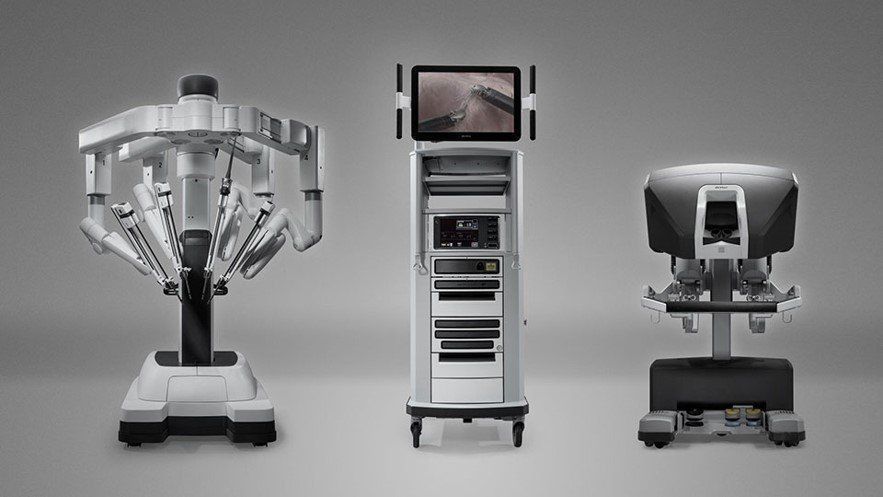Robotic Surgery
What is Robotic Surgery?
Robotic urological surgery is a type of minimally invasive surgery that is performed using a surgical robot. The surgeon sits at a console and operates hand and foot controls to manipulate the robot's arms, which hold small instruments. The robot's arms can move in a way that mimics the movements of the human hand, allowing for precise and accurate surgery.
Robotic urological surgery is commonly used to treat prostate cancer, kidney cancer, bladder cancer and urinary tract issues. It is an alternative to open surgery and laparoscopic surgery. It is considered less invasive, leading to shorter recovery and fewer complications.
The types of urological surgery include:
- Traditional urological surgery or open surgery - is performed through a large incision.
- Laparoscopic urological surgery - a more recent approach that uses a minimally invasive technique where a lighted tube with a camera called a laparoscope is inserted through small incisions to give the surgeon a clear view of the disease.
- Robotic urological surgery - is a more advanced laparoscopic approach. It offers more precision.
Dr Wang is an accredited robotic surgeon who strives to achieve the best patient outcomes.
Who is Suitable for Robotic Urological Surgery?
Robotic urological surgery is typically recommended for patients with conditions such as prostate cancer, kidney cancer, or urinary tract issues that may be treated with surgery.
A patient's suitability for robotic urological surgery will depend on various factors, including the type and stage of their condition, their overall health and medical history.
Patients who are suitable for robotic urological surgery typically have the following:
- Early-stage prostate or kidney cancer
- Benign prostate hyperplasia (BPH)
- Bladder or ureteral cancer
- Nephrectomy (removal of the kidney)
- Pyeloplasty (reconstruction of the renal pelvis)
- Partial nephrectomy (removal of part of the kidney)
Advantages of Robotic Surgery
With the advancements in technology and robotics, it is becoming easier to perform complex surgical procedures with high accuracy and precision and with minimal invasion.
Robotic surgery offers several benefits. Specifically, this approach can improve the outcomes of a procedure by providing the following:
- Enhanced Control - using exact robotic arms deliver improved manoeuvrability when compared with a human hand,
- Less Tissue Damage - using 3D imaging instruments that display the operative field and offer better visualisation of surrounding tissue,
- Less Bleeding & Scarring - as smaller minimally invasive incisions are used,
- Less Pain - as surgery is performed with less surgical trauma,
- Improve Post Op Outcomes - with lower incidences of postoperative complications, and
- Faster Recovery - due to less tissue damage allowing a quicker return to your regular activities.
Robotic surgery also allows sutures inside the body to be more accurate, which could be difficult for even the most skilled surgeons during laparoscopic procedures.
Types of Robotic Urological Surgery
There are several types of robotic urological surgery, including:
- Robotic Prostatectomy: This surgery removes the prostate gland typically used to treat prostate cancer.
- Robotic Nephrectomy: This surgery to remove the kidney is typically used to treat kidney cancer or other conditions.
- Robotic Pyeloplasty: This surgery to reconstruct the renal pelvis is typically used to treat ureteropelvic junction obstruction.
- Robotic Cystectomy is a surgery to remove the bladder, typically used to treat bladder cancer.
- Robotic Partial Nephrectomy: This surgery removes part of the kidney, typically used to treat kidney cancer or other kidney conditions.
- Robotic Simple Prostatectomy: This surgery to remove the prostate gland is typically used to treat benign prostate hyperplasia (BPH).
These are some of the most common types of robotic urological surgery, but new techniques and procedures are continuously being developed.
It is essential to consult with Dr Wang to determine the best option for your specific condition.
Robotic Urological Surgery Procedure
Before Robotic Urological Surgery
- The patient will typically meet with their surgeon and urologist to discuss the procedure and review their medical history.
- The patient will be instructed to prepare for the procedure, such as fasting for a certain period before the surgery and stopping certain medications.
- The patient will be given anaesthesia and placed under general or spinal anaesthesia to prevent pain during the procedure.
During Robotic Urological Surgery
- The surgeon will make small incisions and then, using the robotic arms of the surgical system, will perform the surgery by manipulating the small instruments inside the patient's body.
- The surgery is performed with the help of a high-definition camera that provides the surgeon with a magnified, 3D view of the surgical field, which can help improve the surgery's accuracy and success.
- The procedure can take several hours, depending on the type of surgery and the patient's condition.
After Robotic Urological Surgery
- After the procedure, the patient will be moved to the recovery room to wake up from anaesthesia.
- The patient will be closely monitored for complications, such as bleeding or infection.
- The patient will be given instructions on how to care for themselves at home, such as managing pain, monitoring their incisions, and then following up with their surgeon.
- The recovery time will vary depending on the type of surgery and the patient's condition, but it is generally shorter than open surgery.
Make sure to follow the instructions provided by Dr Wang and the medical team after the procedure. The patient will have follow-up appointments to monitor their recovery and ensure everything is healing correctly.
Robotic Urological Surgery Prognosis
Robotic urological surgery is highly effective in treating prostate cancer, kidney cancer, and urinary tract issues. The surgery is associated with a high rate of success and a low risk of complications.
For prostate cancer, robotic prostatectomy is as effective as traditional open surgery regarding cancer control and survival rates. The benefits of robotic surgery over open surgery include less blood loss, less pain, and a shorter recovery time.
For kidney cancer, robotic nephrectomy is as effective as traditional open surgery regarding cancer control and survival rates. The benefits of robotic surgery over open surgery include less blood loss, less pain, and a shorter recovery time.
For urinary tract issues, such as pyeloplasty, robotic surgery is highly effective in treating the condition and improving the patient's quality of life. The benefits of robotic surgery over open surgery include less blood loss, less pain, and a shorter recovery time.
The success of the surgery also depends on the skill and experience of the surgeon and the medical team, as well as the patient's adherence to the post-operative instructions and follow-up appointments.
It's essential to remember that every patient is different, and their outcomes will vary. It is best to consult your surgeon to understand the specific results of your case.
Robotic Urological Surgery Risks
As with any surgical procedure, there are risks associated with robotic urological surgery. Some of the most common risks include:
- Infection: As with any surgery, there is a risk of infection. This risk can be minimised by following proper surgical techniques and taking antibiotics as directed by your surgeon.
- Bleeding: As with any surgery, there is a risk of bleeding. This risk can be minimised by following proper surgical techniques and taking blood-thinning medications as directed by your surgeon.
- Injury to surrounding organs: During surgery, there is a risk of injury to surrounding organs such as the bladder, rectum, or other organs in the pelvic area. The surgeon's experience and skill can minimise the risk of injury.
- Anaesthesia complications: As with any surgery, there is a risk of complications related to anaesthesia, such as allergic reactions or breathing problems. The anaesthesia team's experience and skill minimise the risk of complications.
- Blood clots: There is a risk of blood clots forming in the legs or lungs after surgery, which can be dangerous and, in rare cases, fatal. This risk can be minimised by getting up and moving around as soon as possible after surgery, wearing compression stockings and taking blood-thinning medications as directed by your surgeon.
- Urinary incontinence: There is a risk of urinary incontinence after prostate surgery, which is more common with traditional open surgery than robotic surgery. However, the risk still exists with robotic surgery, and the patient should be aware of this and discuss it with the surgeon.
- Erectile dysfunction: There is a risk of erectile dysfunction after prostate surgery, which is more common with traditional open surgery than robotic surgery. However, the risk still exists with robotic surgery, and the patient should be aware of this and discuss it with the surgeon.
While these risks are associated with robotic urological surgery, the overall risk is considered low and supposed to be a safe procedure. Dr Wang will discuss the specific risks associated with your procedure and work with you to minimise them.
What if Robotic Urological Surgery is Delayed?
Suppose the delay is due to a minor issue, such as scheduling conflicts or a minor complication that needs to be addressed before the surgery. In that case, it may be possible to reschedule the surgery for later.
Suppose the delay is due to a more severe issue, such as a significant complication or a change in the patient's medical condition. In that case, it may be necessary to consider alternative treatments. For example, suppose the delay is due to a patient's cancer stage change. In that case, the patient and their medical team may need to re-evaluate the course of treatment and consider other options, such as radiation therapy or chemotherapy.
Remember that delaying surgery may impact the patient's condition and prognosis. The patient should discuss the implications of postponing surgery with their surgeon and medical team and make an informed decision.






